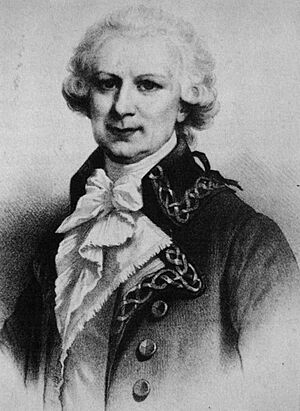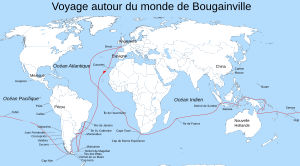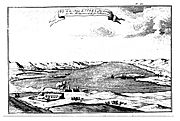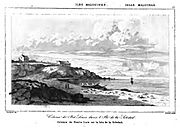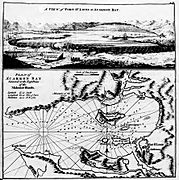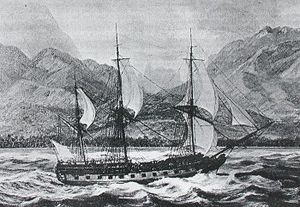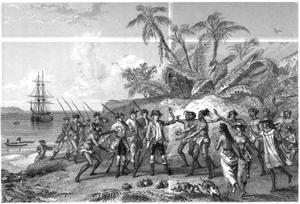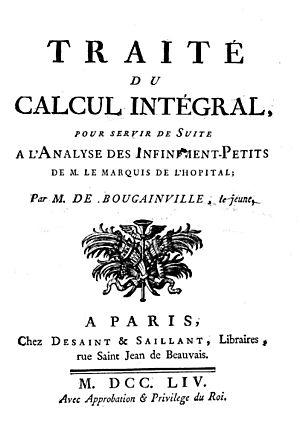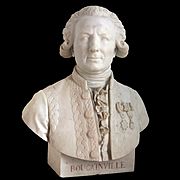Louis Antoine de Bougainville facts for kids
Quick facts for kids
Louis Antoine de Bougainville
|
|
|---|---|
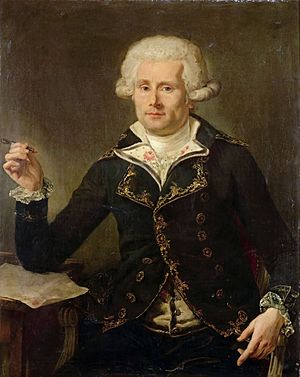 |
|
| Born | 12 November 1729, 11 November 1729 |
| Died | August 1811 |
| Occupation | Admiral and explorer |
| Signature | |
 |
|
| Position held | member of the Sénat conservateur |
Louis-Antoine, Comte de Bougainville (born 12 November 1729 – died August 1811) was a famous French admiral and explorer. He lived at the same time as the well-known British explorer James Cook. Bougainville played a part in two major wars: the Seven Years' War in North America and the American Revolutionary War against Britain.
He became very famous for his voyages around the world. These included the first French trip around the globe with scientists. He also helped start the first recorded settlement on the Falkland Islands. The beautiful Bougainvillea flower and Bougainville Island in Papua New Guinea are named after him.
Who Was Louis Antoine de Bougainville?
Early Life and Studies
Louis Antoine de Bougainville was born in Paris, France, in 1729. His father was a notary, which is like a legal official. Young Louis first studied law, but he soon decided it wasn't for him.
At age 25, he joined the army as a musketeer. He also showed he was very smart by writing a book about integral calculus. This is a complex part of mathematics.
In 1755, he went to London to work for the French embassy. While there, he became a member of the Royal Society, a famous group of scientists.
Fighting in the Seven Years' War
In 1756, Bougainville was sent to Canada. He was a captain in the dragoons and a special assistant (called an aide-de-camp) to the Marquis de Montcalm, a French general. He fought bravely in several battles, including the capture of Fort Oswego in 1756. He also took part in the Battle of Fort William Henry in 1757.
In 1758, he was hurt while successfully defending Fort Carillon. The next winter, he sailed back to France. His mission was to get more supplies for the French forces in Canada. He learned a lot about sailing during this trip.
Bougainville was honored with the Cross of St Louis and became a colonel. However, he returned to Canada with very few supplies. French officials felt that helping Canada was less important than protecting France itself.
In 1759, Bougainville helped defend Quebec, the capital of New France. He led a small, skilled group of soldiers. They patrolled the St. Lawrence River to stop the British from landing. He tried to help when the British attacked Quebec on 13 September, but it was too late.
After Quebec fell, Bougainville continued to fight near Montreal. He was among the officers who made the last stand for France in North America. He wrote in his journal that war was "abominable."
After the war, Bougainville was sent back to Europe. He was not allowed to fight against the British anymore. He spent the next few years as a diplomat. He helped negotiate the Treaty of Paris in 1763. This treaty gave much of New France to the British Empire.
Sailing Around the World
After the war, Bougainville wanted to explore. He decided to help French settlers, called Acadians, who had been forced to leave their homes by the British. He planned to settle them on the "Isles Malouines," now known as the Falkland Islands.
Starting a Colony in the Falklands
In September 1763, Bougainville left France with two ships. One was L'Aigle (The Eagle) and the other was Le Sphinz (The Sphinx). The expedition included scientists and a priest.
They arrived in January 1764 and landed at Port Louis. This place was named after King Louis XV. Bougainville officially claimed the islands for France.
However, the French government later ordered him to sell the colony to Spain. This was partly because Bougainville had paid for the expeditions himself. Also, Spain worried that the islands could be used by Britain to attack its gold mines in Peru. Bougainville received a large sum of money for the colony. In 1767, he transferred the islands to Spain.
- Îles Malouines settlement
The Big Voyage Begins
In 1766, King Louis XV gave Bougainville permission to sail around the world. He would be the 14th person, and the first Frenchman, to do so. This journey helped France regain its pride after losing the Seven Years' War. It was also the first trip around the world with professional scientists on board.
Bougainville left France in November 1766 with two ships: Boudeuse and Étoile. There were many people on board, including a botanist named Philibert Commerçon. He was the one who named the beautiful Bougainvillea flower.
A special person on the trip was Jeanne Baret. She disguised herself as a man to join the expedition. She later became the first woman known to sail around the world! Other important people included an astronomer and a cartographer.
Discovering Tahiti and More
On 2 April, Bougainville saw the island of Otaheite. He almost discovered it, but another British explorer, Samuel Wallis, had been there less than a year before. Bougainville claimed the island for France and called it New Cythera.
After leaving Tahiti, his expedition sailed west. They saw islands in Samoa and the New Hebrides. He almost found the Great Barrier Reef but had to change course. He sailed through the Solomon Islands and named Bougainville Island after himself.
The expedition faced attacks from people in New Ireland. So, they sailed to the Moluccas. There, they heard that Wallis and Carteret had already discovered Tahiti before them.
Back Home and a Famous Book
On 16 March 1769, Bougainville's expedition finished its journey. They arrived back in France at St Malo. Only seven of the 340 crew members were lost, which was a very low number for such a long voyage. This showed how well Bougainville managed the expedition.
Bougainville brought a Tahitian man named Ahutoru back to France. Ahutoru volunteered to come. Bougainville introduced him to French high society, even to the King and Queen at Versailles. Bougainville also helped pay for Ahutoru's trip back to Tahiti. Sadly, Ahutoru died of smallpox on the way home in 1771.
In 1771, Bougainville published a book about his travels. It was called Le voyage autour du monde (A Voyage Around the World). The book described the places he visited, like Argentina, Patagonia, Tahiti, and Indonesia.
The book became very popular, especially his descriptions of Tahitian society. Bougainville wrote about Tahiti as a peaceful paradise. He said the people lived simply and happily, far from the problems of civilization. His ideas influenced thinkers like Jean-Jacques Rousseau and even the French Revolution.
Helping in the American Revolution
After his world voyage, Bougainville returned to naval service. In 1777, he commanded a large warship called the Bien-Aimé. He played an important role in the War of American Independence. He helped the French win a key battle called the Battle of the Chesapeake.
Later, at the Battle of the Saintes, Bougainville commanded another large ship, the Auguste. Even after a French defeat, he managed to gather eight ships from his group. He safely brought them to Saint Eustace. He was then promoted to a higher naval rank. When he rejoined the army, he became a maréchal de camp, a high military position.
After the Peace of Paris in 1783, Bougainville returned to Paris. He became a member of the Académie de Marine, a naval academy. He even suggested a trip to the North Pole, but the French government did not support it.
Later Life and Achievements
In 1787, Bougainville became a member of the French Academy of Sciences. He was promoted to vice-admiral in 1791.
During the dangerous time of the Reign of Terror in France, he managed to escape. He retired to his home in Normandy. Later, he returned to Paris and helped start the Bureau des Longitudes, a group focused on astronomy and navigation. In 1799, Napoleon made him a senator. Bougainville died in Paris in August 1811.
What is Bougainville's Legacy?
Louis Antoine de Bougainville left a lasting mark on the world.
- Bougainville's name is given to the largest eastern island of Papua New Guinea. It is also given to the strait that separates it from Choiseul. Another strait in the New Hebrides is also named after him. In the Falkland Islands, Port Louis and "Isla Bougainville" (Lively Island's Spanish name) remember him.
- The beautiful genus of South American climbing shrubs with colorful flowers, Bougainvillea, is named after him.
- In 1804, he was made a Grand Officier de la Légion d'honneur. This is a very high French award.
- In 1808, Napoleon gave him the title of count (the Comte de Bougainville).
- Thirteen ships of the French Navy have been named in his honor.
- Legacy
-
Tomb of Louis Antoine de Bougainville, at the Panthéon.
See also
 In Spanish: Louis Antoine de Bougainville para niños
In Spanish: Louis Antoine de Bougainville para niños


